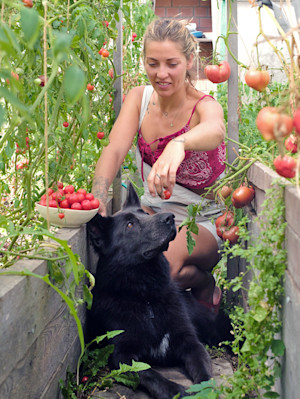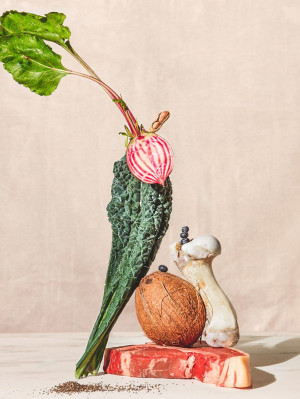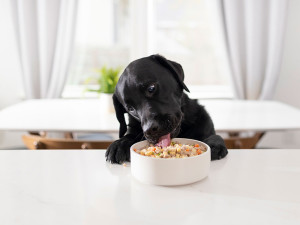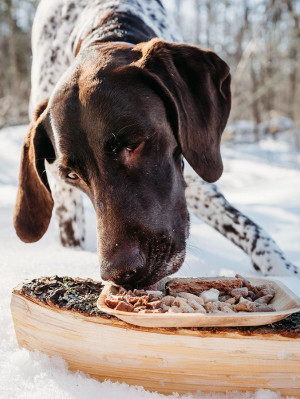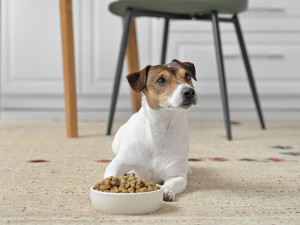Human-Grade Dog Food Brands Are Everywhere—Should Your Pup Indulge?
How to read beyond the buzzwords and find what’s best for your pal.

Share Article
Not too long ago, there were very few options when it came to what we could feed our dogs. We did our best with the few brands that were out there, and our pups were happy with what they had. Recently, though, those options have expanded a ton as the industry has evolved. That evolution is long overdue, and now our dogs eat better than we do most days.
But, with all these choices, it can be hard to tell buzzwords from genuine developments in the pet food industry. Raw, vegan, and grain-free are all terms that have cropped up over the last few years, and many of us are quick to jump on them, wanting to make the best choices for our pets. One of those terms, “human-grade,” refers to food that contains ingredients of such a high quality that even you could eat it. You might not want to, but you could.
Human-grade food is made to the same safety and quality standards found in the FDA and USDA regulations for our food. With high quality, whole cuts of meat, organic vegetables, and line-caught fish, human-grade pet food has stormed the market. The business is growing year over year,opens in new tab and at the Global Pet Expo, human-grade food was a key talking point, with Pet Business editor-in-chief Mark Kalaygian, who wrote that “the humanization of pups is having its biggest impact by making consumers demand nutritional options that mirror their own — or at least the sensibilities of their own nutrition.”
The pros of feeding your dog human-grade
There are many purported benefits of a human-grade diet. Parents who feed their pets human-grade food tend to report better gastrointestinal health, shiny coats, healthy skin and improved health overallopens in new tab. The quality of the proteins present in the food can even make your dog stronger. Particularly for seniors or dogs with higher health needs, human-grade pet food can help to increase their longevity. Improvements in immune system and bone and joint health has also been reported.

Jan Allegretti, a consultant at Holistic Animal Health and Advocacyopens in new tab who has been an educator in holistic care for animals for more than 30 years, believes that “there's a growing awareness of the stark difference between the food we consider ‘healthy’ for our dogs and cats and the healthy foods we choose for ourselves.” As we become more conscientious with our own health, we also make an effort to improve the nutrition of our pets.
How do you go about putting your pet on a human-grade diet? Allegretti believes we should create our pets’ diets based on the principles we use to make our own healthy meals: “A highly-varied diet of fresh whole foods, minimally processed, including plenty of fruits and vegetables. It’s best for us, and it’s also best for our companions — exactly what caregivers are looking for.” Allegretti adds that “human-grade” should mean that it wouldn’t look out of place on your dinner plate.
Taking out the guesswork
If you’re looking to make the switch, it’s better to buy food pre-prepped by experts who know how to get the delicate balance of nutrients just right. First, talk to your vet about which human-grade-food brands they might recommend.
When you go to any leading human-grade food brand’s site, you’ll fill out a survey, they’ll prepackage a set amount of food for the month that you can freeze and feed your dog every single day. It comes at a set price, too, so you don’t need to worry about being blindsided by the cost.
Why research is essential
Kimberly Gauthier is a pet nutritionist and the author of Raw Feeding From A to Zopens in new tab. She warns that, while “human grade” might sound attractive, it can be utilized as a buzzword by companies who don’t actually adhere to the standards set by the industry.
“Not all products using this label are products I would feed my dogs or recommend to others. It’s important to look beyond the human-grade label and inquire about sourcing, ingredients, and processing,” she says. The meat might be from factory farms, other ingredients could include synthetic nutrients, and the way it is processed might destroy beneficial bacteria. She believes that you should always do the research yourself and work with professionals to make sure you’re making the best decision for your pet.
While “human-grade” might seem like yet another industry buzzword claiming to be the best option for your pet, it does just seem to make sense. You want your pet to be as healthy as you, so why wouldn’t you feed them something that you would put into your own body? Fun stuff like chocolate and wine aside, of course.
As always, if you’re looking to make a change to your pet’s diet, you should work with a professional, like your vet or a qualified nutritionist, to pinpoint their needs and areas of concern. Every pup is different, and none of these offerings are one-size-fits-all. And, of course, resist the temptation to steal any food out of their bowl. No matter how tasty it looks.
References:

Marianne Eloise
Marianne Eloise’s work has appeared in The New York Times, The Guardian, The Cut, Vulture, and more. She is also the author of an essay collection Obsessive, Intrusive, Magical Thinkingopens in new tab. She has been going on adventures with her dog Bowie since she was 17.
Related articles
![a black dog eats from a white bowl]()
8 Best Fresh Food Delivery Services For Dogs
Feeding your dog healthy whole foods is easier than ever.
![Side view of a cute hungry dog standing next to a red bowl with food in a studio with white background]()
How to Get a Dog to Eat
You can’t appease your picky new dog with chicken nuggets like you can with your toddler. Here are some things you can do.
![Large brown dog and Vital Essentials butcher cuts freeze dried dog food.]()
6 of the Best Freeze-Dried Dog Foods For the Raw Curious
A veterinary nutritionist weighs in on how best to approach the diet plan.
![Puppy eating a bowl of blueberries]()
10 Superfoods You Should Share With Your New Dog
From kale to quinoa, these nutrient-packed picks deserve a spot in your dog’s food bowl.
![A dog sitting on the floor with a bowl of kibble.]()
Everything You Need to Know About Your Dog’s Gut Microbiome
Microscopic organisms may reveal pathways to better health for your pet.
![Close Up Of Female Owner Feeding Border Terrier Puppy With Dry Dog Food At Home.]()
The Ultimate Guide to Your New Dog’s Nutrition
From kibble to homemade food, these tips will help you learn the fundamentals of dog nutrition.

